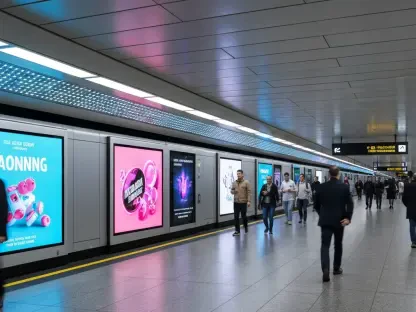In the high-stakes arena of digital advertising, a single millisecond can determine whether an ad reaches its target audience or fades into obscurity, and with global brands launching campaigns during major events like sporting spectacles, every bid in real-time bidding (RTB) must execute flawlessly to secure prime ad slots. Picture this: millions of viewers are online, and outdated systems often lag, costing advertisers both time and revenue. Enter a transformative solution from IAB Tech Lab—a cutting-edge framework designed to overhaul this lightning-fast ecosystem with unprecedented speed and efficiency. This innovation promises to reshape how digital ads are traded in real time.
The significance of this development cannot be overstated. With programmatic ad spend projected to surpass $700 billion by 2026, the industry faces mounting pressure to eliminate inefficiencies that hinder performance. The newly introduced Agentic RTB Framework (ARTF) v1.0 stands as a pivotal response to these challenges, offering a standardized approach to streamline interactions and slash delays in ad trading. This isn’t just a technical update; it’s a lifeline for an industry racing against time, ensuring advertisers can seize fleeting opportunities in a hyper-competitive market.
Why Speed Defines Success in Digital Advertising
Every second counts in the digital ad space, where latency can turn a winning bid into a missed opportunity. The time it takes for bid requests and responses to travel between platforms—often 600 to 800 milliseconds—can mean losing out on high-value impressions during peak traffic moments like holiday sales or live events. Advertisers and platforms have long grappled with these delays, watching potential revenue slip through their fingers due to sluggish systems.
The introduction of ARTF v1.0 marks a turning point in addressing this critical issue. By prioritizing speed, this framework aims to redefine the pace of programmatic advertising, ensuring that split-second decisions translate into tangible results. Early tests reveal that platforms adopting faster bidding processes see up to a 20% increase in impression wins, underscoring the direct link between reduced latency and competitive advantage.
The Pressing Demand for a Smarter Programmatic Landscape
As digital advertising evolves, the complexity of data-driven campaigns has surged, fueled by AI algorithms and intricate targeting strategies. This sophistication, while powerful, often strains existing RTB systems, amplifying the need for a more agile infrastructure. With billions of ad transactions occurring daily, even minor bottlenecks can cascade into significant financial losses across the supply chain.
ARTF emerges as a tailored solution to these systemic hurdles, focusing on standardized interactions within shared data environments. Beyond just speed, it addresses the growing call for sustainability by minimizing computational overhead, a factor increasingly scrutinized as the industry faces criticism for its environmental impact. This dual focus on efficiency and responsibility signals a shift toward a more thoughtful programmatic ecosystem.
The stakes are high, and the timing couldn’t be more critical. As AI continues to dominate bidding strategies, platforms that fail to adapt risk falling behind in a landscape where precision and responsiveness are non-negotiable. This framework offers a blueprint for staying ahead, tackling both current pain points and future demands.
Core Features That Set ARTF Apart
At the heart of ARTF v1.0 lies a suite of innovations engineered to revolutionize real-time bidding. One standout feature is its ability to cut bid request-response latency by up to 80%, shrinking round-trip times to a mere 100 milliseconds. This leap forward enables advertisers to make richer, data-informed decisions almost instantly, a game-changer during high-traffic events.
Interoperability is another cornerstone, with the framework standardizing containerized interactions between demand-side platforms (DSPs) and supply-side platforms (SSPs) in shared data centers. Additionally, it supports modern tools like the Model Context Protocol (MCP), facilitating seamless agent-to-agent communication. These advancements ensure that disparate systems can work in harmony, eliminating friction that once slowed transactions.
Equally noteworthy is the emphasis on energy efficiency. By reducing the computational load, ARTF not only boosts performance but also lowers energy consumption—a vital consideration for an industry aiming to improve its sustainability footprint. Pilot programs have already demonstrated measurable gains, with some platforms reporting a 15% reduction in server energy use after early adoption.
Voices of Support from Industry Pioneers
The enthusiasm surrounding ARTF isn’t confined to technical specs; it resonates deeply with leaders across the digital advertising spectrum. Anthony Katsur, CEO of IAB Tech Lab, describes the framework as a foundational move toward a “modernized, virtualized programmatic ecosystem,” emphasizing its role in fostering high-performance, interoperable systems. His perspective highlights a broader vision for the industry’s evolution.
Echoing this sentiment, Joshua Prismon, Chief Architect at Index Exchange, labels the specification as “production-tested” and “transformational,” pointing to its proven impact in live environments. Meanwhile, Adam Heimlich, CEO of Chalice, envisions ARTF redefining AI-driven optimization, predicting a future where programmatic media achieves new heights of precision. These endorsements reflect a rare alignment among key players, signaling confidence in the framework’s potential.
This collective optimism isn’t mere rhetoric; it underscores a unified push to overcome longstanding inefficiencies. With such backing, ARTF stands poised to gain traction rapidly, as stakeholders recognize its capacity to address both immediate challenges and long-term goals in ad trading.
Strategies to Maximize ARTF in Advertising Campaigns
For those in the advertising realm looking to capitalize on this innovation, actionable steps can turn ARTF’s promise into reality. Engaging with the framework during its public comment period, open until January 15, 2026, offers a chance to explore its technical details and contribute feedback via GitHub. This collaborative process ensures the specification evolves to meet diverse industry needs.
Partnering with DSPs and SSPs to implement ARTF’s standardized setups in shared data centers is another key move. This approach prioritizes speed, allowing for quicker bid decisions that can enhance campaign outcomes. Additionally, experimenting with supported protocols like MCP can unlock advanced data integration, empowering AI-driven strategies to perform at their peak.
Sustainability should also factor into adoption plans. By leveraging ARTF’s energy-efficient design, advertisers and platforms can reduce their operational carbon footprint, aligning with broader demands for greener practices. Taking these steps positions stakeholders to not only improve performance but also lead in an increasingly conscientious market.
Reflecting on a Milestone for Digital Advertising
Looking back, the unveiling of ARTF v1.0 stood as a defining moment for the programmatic advertising world, addressing critical inefficiencies with bold innovation. The framework’s focus on slashing latency, enhancing interoperability, and promoting sustainability offered a much-needed remedy to challenges that had long plagued the industry. Industry leaders championed its arrival, their unified support amplifying its credibility and reach.
As the public comment period unfolded, it became clear that this wasn’t just a fleeting update but a foundation for lasting change. The next steps rested with advertisers, agencies, and platforms to actively integrate these advancements, refining their strategies to harness the full potential of faster, smarter ad trading. Beyond immediate gains, the emphasis on collaboration hinted at even greater possibilities, inviting the ecosystem to shape future iterations together.
Ultimately, the journey sparked by ARTF encouraged a forward-thinking mindset, urging all players to rethink how speed and efficiency could redefine success. The challenge was set: adapt to this new standard, explore emerging protocols, and commit to sustainable practices. Doing so promised not just to keep pace with a dynamic market but to drive its evolution for years to come.









